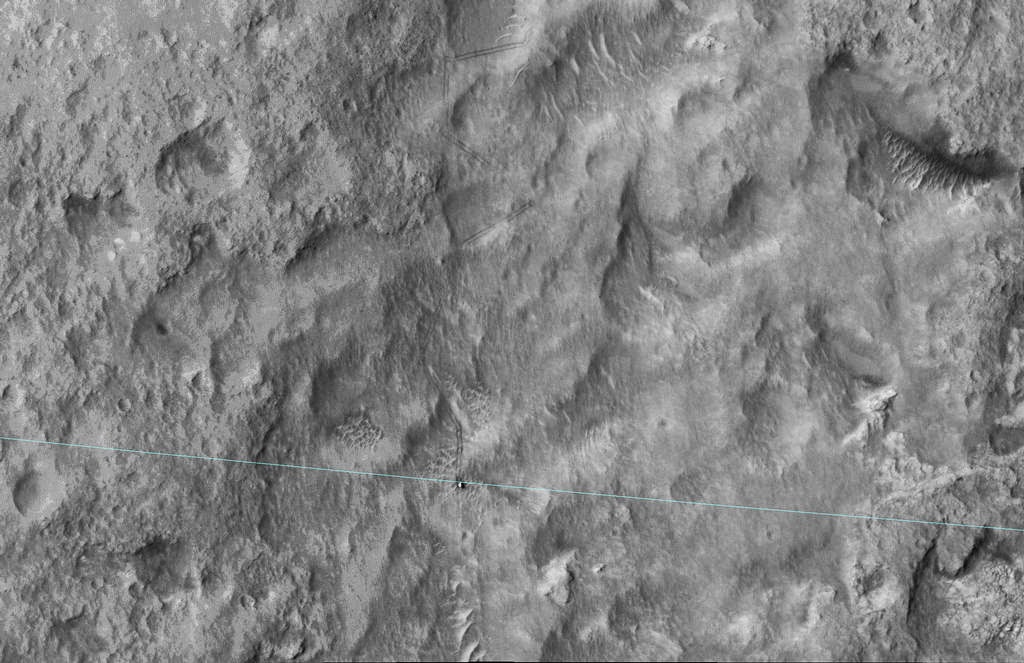For today's blog posting I decided to check in with the Mars rover, Curiosity. Curiosity is a car-sized robotic rover currently exploring Gale Crater. This incredible roaming scientific laboratory was launched from Cape Canaveral on November 26, 2011 and successfully landed on August 6, 2012. The Bradbury Landing site was less than 2.4 km (1.5 mi) from the center of the rover's touchdown target after a 563,000,000 km (350,000,000 mi) journey. The rover's goals include: investigation of the Martian climate and geology; assessment of whether the selected field site inside Gale Crater has ever offered environmental conditions favorable for microbial life, including investigation of the role of water; and planetary habitability studies in preparation for future human exploration. Curiosity's design will serve as the basis for a planned Mars 2020 rover mission. In December 2012, Curiosity's two-year mission was extended indefinitely.
The rock shown above discovered by NASA's Curiosity Mars rover is an iron
meteorite called "Lebano." This specimen is similar in shape and luster to iron
meteorites found on Mars by the previous rovers, Spirit
and Opportunity. Lebanon is about 2 yards or 2 meters wide. The smaller piece in the foreground is called
"Lebanon B."
The imaging shows angular shaped cavities on the surface of the rock.
One possible explanation is that they resulted from preferential erosion
along crystalline boundaries within the metal of the rock. Another
possibility is that these cavities once contained olivine crystals,
which can be found in a rare type of stony-iron meteorites called
pallasites, thought to have been formed near the core-mantle boundary
within an asteroid.
Iron meteorites are not rare among
meteorites found on Earth, but they are less common than stony
meteorites. On Mars, iron meteorites dominate the small number of
meteorites that have been found. Part of the explanation could come from
the resistance of iron meteorites to erosion processes on Mars.
NASA's Curiosity Mars rover is stepping on the boundary line added to this June 27, 2014, image captured by a camera on
NASA's Mars Reconnaissance Orbiter. The line represents the edge of the ellipse that was
charted as safe terrain for the rover's August 2012 landing. Curiosity
is visible right on the ellipse line in the lower center of the image.
This 3-sigma landing ellipse is about 4 miles long and 12 miles wide (7
kilometers by 20 kilometers). Curiosity reached the edge of it for the
first time with a drive of about 269 feet (82 meters) earlier that day. The 3-sigma landing ellipse is a statistical prediction to determine how far from a targeted center point the rover
might land, given uncertainties such as the atmospheric conditions on
landing day. The "3-sigma" part means three standard deviations, so the
rover was very, very likely (to about the 99.9-percent level) to land
somewhere inside this ellipse. Such 3-sigma ellipses got a lot of
scrutiny during landing-site selection to guarantee a safe landing.
The Mars Science Laboratory mission did not try to land
Curiosity right at the base of Mount Sharp, where the most interesting
terrains lay, as seen from orbit. To do so would have put unsafe slopes
within the landing ellipse. Instead, the rover spent almost exactly one
Martian year (687 Earth days) roving and exploring before arriving at
the edge of the ellipse.
Now that Curiosity is outside the
safe-to-land ellipse, the landscape it traverses will get even more
interesting. The rover can drive around landscape features that would
have been dangerous to land on. Both the scenery and the geology should
be even more exciting in the next Mars year.
This map shows in red the route driven by NASA's Curiosity Mars rover
from the "Bradbury Landing" location where it touched down in August
2012 (blue star at upper right) through the 663rd Martian day, or sol,
of the rover's work on Mars (June 18, 2014). The white line shows the
planned route ahead to reach "Murray Buttes" (at white star), the chosen
access point to destinations on Mount Sharp.
The rover completed its mission goal of working for a full Martian year on Sol 669
(June 24, 2014). A Martian year is 687 Earth days.
CITES:
http://en.wikipedia.org/wiki/Curiosity_%28rover%29
NASA/JPL-Caltech/LANL/CNES/IRAP/LPGNantes/CNRS/IAS/MSSS
NASA/JPL-Caltech/Univ. of Arizona
ASA/JPL-Caltech/Univ. of Arizona/USGS
Sunday, July 27, 2014
Subscribe to:
Post Comments (Atom)




No comments:
Post a Comment